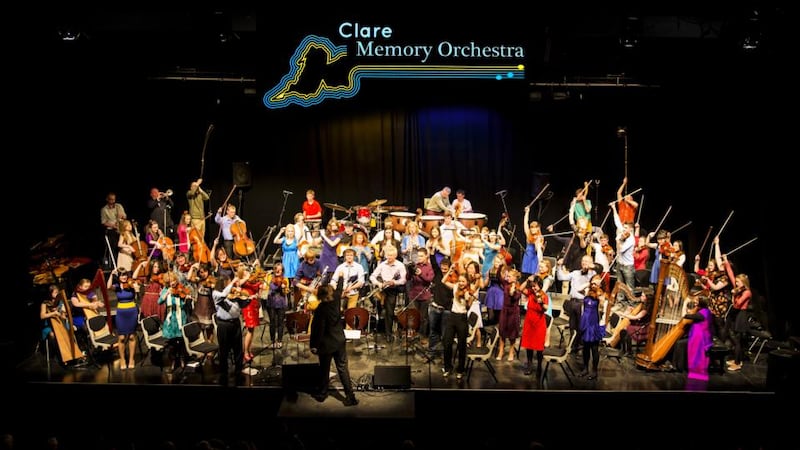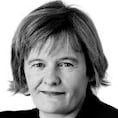The cross-fertilisation of musical forms is nothing new. Just ask Bach, Dave Brubeck, Chris Thile or Seán Ó Riada. Baroque music has influenced jazz, folk music has insinuated its way into classical music and Irish traditional music has been open to the influence of classical forms on occasion.
Later this month the second Ceol Meabhair Festival of Memorised Music will dive deep into those same cross- currents, when composer Dave Flynn and his 70-piece Clare Memory Orchestra perform a series of works written for an orchestral setting, but with a traditional emphasis on musical memory. Younger musicians will also have a chance to perform with the Clare Memory Orchestra.
Flynn’s vision for this large-scale project was well- defined from the beginning.

“I love orchestral music and I love traditional music, and I wanted to try to find ways of blending the two styles in a new way where the practices of traditional music blended seamlessly with those of classical music within a contemporary sound world,” he says. “The sound of the Clare Memory Orchestra lies somewhere between a big trad session, a modern classical orchestra, a jazz big band and an African rumba orchestra.”
A defining trait of the Clare Memory Orchestra is that the musicians perform without sheet music. Flynn was adamant that tapping into traditional musicians’ highly developed capacity to memorise tunes had the potential to transform our usual expectations of an orchestral performance and sound.
“When the musicians perform from memory, they know the music intimately,” Flynn says. “They have spent a long time learning it by heart, so they have really lived with the music in a way that isn’t the case with musicians who rely on sheet music.
“Composers of classical orchestra music rarely receive more than one or two rehearsals with orchestras, so they have to put so much detail into notating their scores so that the players can literally read the composers’ intention without speaking with him/her.
“After a few experiences of this method, I felt it really wasn’t the way to get my music played properly, particularly since my music combines different styles with very different musical languages.”
Rhythmic pulse
Martin Hayes, the musician who first inspired Flynn, muses on the role that memory plays in this orchestral setting.
“There are more things to remember anyway, that’s for sure,” he says. “I think it takes a longer time to pull a piece of music together in an orchestral setting, but it forces people into being there with the music when they’re playing.
“There have been a number of occasions where I’ve played with the orchestra when I’ve felt a really strong rhythmic pulse begins to appear. It happens because everybody’s playing more from a listening perspective, and to be very honest, it feels just like a really big band rather than an orchestra.”
Flynn believes the qualities a traditional musician brings to bear on a piece of music morph the boundaries between composer and performer, which he relishes.
“The best traditional music soloists tend to have a different aim [to classical musicians] which is more personal,” Flynn says. “It’s more about developing their own distinctive style, which involves a completely individual interpretation whereby the tempo, key, instrumentation, ornamentation and variations are entirely up to the traditional musician to choose – and they are often chosen on the spot, with no preparation. So in a sense, these trad musicians are like improvising composers.
"It would be hugely frowned upon for a classical violinist to change a single note in a Bach Partita to suit their own personal taste, whereas great fiddlers like Martin Hayes, Tommy Potts, Tommy Peoples and Liz Carroll are widely praised for creating their own unique interpretations of traditional tunes which are vastly different from the notated versions found in tune books."
Musical instinct
Hayes also recognises and respects the constraints imposed by the orchestral setting, even if – at times – they corral his musical instinct for improvisation.
“This has been the area of most discomfort for me, I suppose,” he says. “It can be the most challenging, for a most purely bred traditional musician to the core.
“It’s an unfamiliar territory for me and it challenges my sense of freedom on stage, which normally allows me to change a tune whenever I feel like it: to do whatever I want, whenever I want. In this situation, I really have to take careful note, because it’s not possible to swing 70 musicians around in a shot if you change your mind. I have to really be more alert to that kind of thing than I normally would be.”
Audiences seeing the Clare Memory Orchestra for the first time may be astounded at the informality and communication between the musicians. Feet tapping, vibrato is nowhere to be heard and the absence of sheet music means musicians connect with one another on the fly.
Then there’s the appearance of Irish instruments such as the pipes, concertina, whistle and bodhrán, alongside the oboe and silver flute.
“More and more I think that those instruments have more of a place in Irish music than we realise,” Hayes says. “The music in my opinion is something that exists independent of the instrument in reality. If there’s one true place where it exists, it’s probably the human voice.
“But we use all kinds of instruments, and the oboe is absolutely beautiful. There’s one piece where the fiddle and oboe are duetting for a tiny little bit, and I look forward to it every time. There are some beautiful instruments that we’ve never thought about that add beautiful textures.”
- The Burren Summer School of Music and Culture, incorporating the second Ceol Meabhair Festival of Memorised Music, takes place in Ballyvaughan, Ennis and Ennistymon, Co Clare, July 20th-26th. clarememoryorchestra.com

















